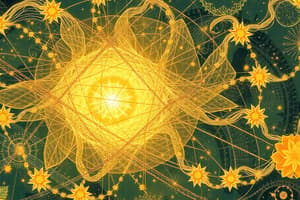Podcast
Questions and Answers
What is the unit of kinetic energy?
What is the unit of kinetic energy?
- Newtons (N)
- Kilograms (kg)
- Meters per second (m/s)
- Joules (J) (correct)
What is the formula for Newton's Second Law of Motion?
What is the formula for Newton's Second Law of Motion?
- F = ma (correct)
- F = mv
- F = v^2
- F = m/v
What is the characteristic of an object that makes it harder to stop?
What is the characteristic of an object that makes it harder to stop?
- Kinetic energy
- Inertia (correct)
- Friction
- Gravity
What type of friction prevents an object from moving?
What type of friction prevents an object from moving?
What is the direction of the force of gravity between two objects?
What is the direction of the force of gravity between two objects?
What is the factor that affects friction between two surfaces?
What is the factor that affects friction between two surfaces?
According to Newton's First Law of Motion, what will an object in motion do when no external force is applied?
According to Newton's First Law of Motion, what will an object in motion do when no external force is applied?
What is the result of the interaction between two objects, according to Newton's Third Law of Motion?
What is the result of the interaction between two objects, according to Newton's Third Law of Motion?
Flashcards are hidden until you start studying
Study Notes
Force and Motion
Kinetic Energy
- Definition: The energy of an object in motion.
- Formula: KE = (1/2)mv^2, where m is mass and v is velocity.
- Units: Joules (J)
- Characteristics:
- Increases with speed and mass.
- Transfers from one object to another through collisions.
Newton's Laws
First Law (Law of Inertia)
- An object at rest will remain at rest, and an object in motion will continue to move with a constant velocity, unless acted upon by an external force.
- Inertia: The tendency of an object to resist changes in its motion.
Second Law (F = ma)
- Force (F) is equal to the mass (m) of an object multiplied by its acceleration (a).
- Formula: F = ma
- Units: Newtons (N)
Third Law (Action and Reaction)
- For every action, there is an equal and opposite reaction.
- When two objects interact, they apply forces to one another that are equal in magnitude and opposite in direction.
Inertia
- The tendency of an object to resist changes in its motion.
- Depends on the mass of the object.
- Examples:
- A bowling ball is harder to stop than a tennis ball due to its larger mass.
- A car's inertia keeps it moving in a straight line until the brakes are applied.
Friction
- A force that opposes motion between two surfaces in contact.
- Types:
- Static friction: Prevents an object from moving.
- Kinetic friction: Slows down an object in motion.
- Factors affecting friction:
- Surface roughness
- Normal force (force perpendicular to the surface)
- Surface area in contact
Gravity
- A force that attracts two objects with mass towards each other.
- Formula: F = G * (m1 * m2) / r^2, where G is the gravitational constant, m1 and m2 are the masses, and r is the distance between them.
- Characteristics:
- Always attractive, never repulsive.
- Weakens with distance.
- Acts on all objects with mass, regardless of their motion.
Force and Motion
Kinetic Energy
- Kinetic energy is the energy of an object in motion, calculated by the formula KE = (1/2)mv^2, where m is mass and v is velocity.
- Kinetic energy is measured in Joules (J).
- It increases with speed and mass, and is transferred from one object to another through collisions.
Newton's Laws
First Law (Law of Inertia)
- An object at rest will remain at rest, and an object in motion will continue to move with a constant velocity, unless acted upon by an external force.
- Inertia is the tendency of an object to resist changes in its motion.
Second Law (F = ma)
- Force (F) is equal to the mass (m) of an object multiplied by its acceleration (a).
- The formula to calculate force is F = ma.
- Force is measured in Newtons (N).
Third Law (Action and Reaction)
- For every action, there is an equal and opposite reaction.
- When two objects interact, they apply forces to one another that are equal in magnitude and opposite in direction.
Inertia
- Inertia is the tendency of an object to resist changes in its motion.
- It depends on the mass of the object.
- The more massive an object, the more inertia it has.
Friction
- Friction is a force that opposes motion between two surfaces in contact.
- There are two types of friction: static friction and kinetic friction.
- Factors affecting friction include surface roughness, normal force (force perpendicular to the surface), and surface area in contact.
Gravity
- Gravity is a force that attracts two objects with mass towards each other.
- The formula to calculate gravity is F = G * (m1 * m2) / r^2, where G is the gravitational constant, m1 and m2 are the masses, and r is the distance between them.
- Gravity is always attractive, never repulsive, and weakens with distance.
- It acts on all objects with mass, regardless of their motion.
Studying That Suits You
Use AI to generate personalized quizzes and flashcards to suit your learning preferences.




